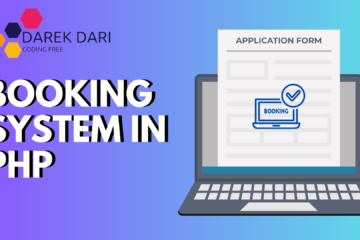
Table of Contents
Introduction to Quiz Application In PHP
Welcome to this exciting tutorial on building a Quiz Application in PHP! Whether you’re a student looking to practice your coding skills or a developer interested in creating a practical project, this guide is perfect for you.
PHP Projects:
- Quiz Application in PHP
- PHP Image Gallery Project Source Code
- Best 200 Questions Game in PHP
- Bulletin Board PHP Project
- Content Management System (CMS) PhP Project
- Event Management System Project in PHP
- Personal Blog with PHP
- Chatbot in PHP
- URL Shortenee in php
We’ll take you through the entire process step-by-step, from setting up your database to implementing the PHP logic that powers the application.
Why should you build a Quiz Application? Here are a few reasons:
- Quiz applications are excellent for learning and teaching. They can be used in classrooms, online courses, or for self-study to test knowledge on various topics.
- Building a quiz app helps you enhance your coding skills, especially in PHP and MySQL. It covers a wide range of functionalities, including form handling, database interactions, and user authentication.
- Adding a well-designed and functional quiz application to your portfolio can impress potential employers or clients. It showcases your ability to create dynamic, data-driven web applications.
- Quiz applications are enjoyable! They engage users and provide a challenging yet entertaining experience.
In this tutorial, we’ll cover the following:
- Setting Up the Database: We’ll start by creating the necessary tables to store quizzes, questions, options, and user performance data.
- Designing the User Interface: Using HTML and CSS, we’ll create a user-friendly interface where users can take quizzes.
- Implementing PHP Logic: We’ll write the PHP code to handle quiz creation, submission, and scoring. We’ll also include features to track user performance.
- Enhancements and Security: We’ll discuss how to add user authentication, create an admin panel, improve the UI, and secure the application.
By the end of this guide, you’ll have a fully functional quiz application that you can customize and expand. Are you ready to get started? Let’s dive in!
photo gallery php
php exercises
php exercises and solutions
php exercises and solutions pdf
php exercises online
php lab exercises
php mvc framework from scratch
php mvc from scratch
What is quiz application?
A quiz app is a powerful tool for making, organizing, and managing quizzes, commonly used in education, training, or just for fun. It enables teachers to make different question types, like multiple-choice or true/false, and include multimedia to boost engagement.
Students can log in securely, take quizzes, and get immediate feedback, aiding their learning and pinpointing areas for improvement.
Administrators can use tracking tools to monitor progress and create detailed reports.Developing a quiz app involves creating a database to organize data, establishing user roles, and designing user-friendly interfaces for quiz creation and participation.
Security is crucial to safeguard user information. In general, a quiz app is adaptable and enriches learning, offering valuable insights and an easy-to-use experience for both creators and participants.
php exercises
php lab exercises
php mvc folder structure best practices
php mvc framework from scratch
php mvc from scratch
php mvc project
php photo database
php photo gallery
php practice exercises
php project source code
php projects source code
php projects with source code github
php realtime chat
Step 1: Setting Up the Database
First things first, we need a place to store all our quiz data. Let’s set up a MySQL database with tables for quizzes, questions, options, and user performance.
CREATE DATABASE quiz_app;
USE quiz_app;
CREATE TABLE quizzes (
id INT AUTO_INCREMENT PRIMARY KEY,
title VARCHAR(255) NOT NULL,
description TEXT
);
CREATE TABLE questions (
id INT AUTO_INCREMENT PRIMARY KEY,
quiz_id INT,
question_text TEXT,
FOREIGN KEY (quiz_id) REFERENCES quizzes(id)
);
CREATE TABLE options (
id INT AUTO_INCREMENT PRIMARY KEY,
question_id INT,
option_text VARCHAR(255),
is_correct BOOLEAN,
FOREIGN KEY (question_id) REFERENCES questions(id)
);
CREATE TABLE user_performance (
id INT AUTO_INCREMENT PRIMARY KEY,
user_id INT,
quiz_id INT,
score INT,
time_taken INT
);Step 2: Crafting the User Interface
Let’s make our quiz application look nice with some HTML and CSS. Here’s a simple structure to get started:
<!DOCTYPE html>
<html>
<head>
<title>Quiz Application</title>
<style>
body {
font-family: Arial, sans-serif;
background-color: #f4f4f4;
padding: 20px;
}
.quiz-container {
background: #fff;
border-radius: 10px;
padding: 20px;
max-width: 600px;
margin: auto;
box-shadow: 0 0 10px rgba(0, 0, 0, 0.1);
}
.question {
margin-bottom: 20px;
}
.option {
display: block;
margin-bottom: 10px;
}
.submit-btn {
background-color: #4CAF50;
color: white;
padding: 10px 20px;
border: none;
border-radius: 5px;
cursor: pointer;
}
.submit-btn:hover {
background-color: #45a049;
}
</style>
</head>
<body>
<div class="quiz-container">
<h1>Quiz Time!</h1>
<form method="POST" action="submit_quiz.php">
<div class="question">
<p>Question 1</p>
<label class="option"><input type="radio" name="question1" value="1"> Option 1</label>
<label class="option"><input type="radio" name="question1" value="2"> Option 2</label>
<label class="option"><input type="radio" name="question1" value="3"> Option 3</label>
<label class="option"><input type="radio" name="question1" value="4"> Option 4</label>
</div>
<!-- Add more questions here -->
<button type="submit" class="submit-btn">Submit Quiz</button>
</form>
</div>
</body>
</html>Step 3: Adding the PHP Logic
Creating Quizzes and Managing Questions
Here’s how you can create a quiz with PHP:
// create_quiz.php
<?php
$servername = "localhost";
$username = "your_username";
$password = "your_password";
$dbname = "quiz_app";
$conn = new mysqli($servername, $username, $password, $dbname);
if ($conn->connect_error) {
die("Connection failed: " . $conn->connect_error);
}
if ($_SERVER['REQUEST_METHOD'] == 'POST') {
$title = $_POST['title'];
$description = $_POST['description'];
$sql = "INSERT INTO quizzes (title, description) VALUES ('$title', '$description')";
if ($conn->query($sql) === TRUE) {
echo "New quiz created successfully!";
} else {
echo "Error: " . $sql . "<br>" . $conn->error;
}
}
$conn->close();
?>
<form method="POST" action="">
<input type="text" name="title" placeholder="Quiz Title">
<textarea name="description" placeholder="Quiz Description"></textarea>
<button type="submit">Create Quiz</button>
</form>Timed Quizzes and Scoring System
Let’s create a script to handle quiz submission and calculate scores:
// submit_quiz.php
<?php
session_start();
$servername = "localhost";
$username = "your_username";
$password = "your_password";
$dbname = "quiz_app";
$conn = new mysqli($servername, $username, $password, $dbname);
if ($conn->connect_error) {
die("Connection failed: " . $conn->connect_error);
}
$quiz_id = 1; // Example quiz ID
$score = 0;
$time_taken = 0; // Calculate time taken using JavaScript and pass it via POST
foreach ($_POST as $question_id => $selected_option) {
$sql = "SELECT is_correct FROM options WHERE question_id = $question_id AND id = $selected_option";
$result = $conn->query($sql);
if ($result->num_rows > 0) {
$row = $result->fetch_assoc();
if ($row['is_correct']) {
$score++;
}
}
}
$user_id = $_SESSION['user_id']; // Assume user is logged in and user_id is stored in session
$sql = "INSERT INTO user_performance (user_id, quiz_id, score, time_taken) VALUES ($user_id, $quiz_id, $score, $time_taken)";
if ($conn->query($sql) === TRUE) {
echo "Quiz submitted successfully. Your score: $score";
} else {
echo "Error: " . $sql . "<br>" . $conn->error;
}
$conn->close();
?>Tracking User Performance
Finally, let’s create a script to display user performance:
// view_performance.php
<?php
session_start();
$servername = "localhost";
$username = "your_username";
$password = "your_password";
$dbname = "quiz_app";
$conn = new mysqli($servername, $username, $password, $dbname);
if ($conn->connect_error) {
die("Connection failed: " . $conn->connect_error);
}
$user_id = $_SESSION['user_id'];
$sql = "SELECT * FROM user_performance WHERE user_id = $user_id";
$result = $conn->query($sql);
if ($result->num_rows > 0) {
while ($row = $result->fetch_assoc()) {
echo "Quiz ID: " . $row['quiz_id'] . " - Score: " . $row['score'] . " - Time Taken: " . $row['time_taken'] . " seconds<br>";
}
} else {
echo "No performance records found.";
}
$conn->close();
?>Bonus Tips
- User Authentication: Add user registration and login to keep track of different users.
- Admin Panel: Create an admin panel to manage quizzes and questions easily.
- Enhanced UI: Use more advanced CSS and JavaScript to improve the user experience.
- Validation and Security: Always validate user inputs and protect against SQL injection.
How to make an online quiz system?
When starting an online quiz system, it can be an enjoyable and fulfilling endeavor. Here is a helpful guide to walk you through the process, step by step.
Identify Your Requirements
To begin, consider your requirements. Identify the various user roles you will have, such as Admins, Teachers, and Students.
Admins will oversee all aspects, Teachers will develop and manage quizzes, and Students will participate in quizzes and review their results. It is crucial to outline these roles and the specific functionalities each will require.
For example, Admins may need a dashboard to manage user accounts and track quiz performance, while Teachers will require tools to create, modify, and publish quizzes.
Students, on the other hand, will need a user-friendly interface to complete quizzes and access their scores.
Design Your System
Let’s begin by focusing on the user interface design. Take some time to sketch out how you envision the admin, teacher, and student panels to look. It’s important to ensure that the quiz-taking interface is clean and easy to navigate.
At the same time, consider your database design. You’ll need tables for users, quizzes, questions, answers, and results. For users, include details such as ID, name, role, email, and password. Quizzes should have details like ID, title, description, and creator.
Questions should be linked to quizzes, and answers should indicate which ones are correct. Results will record user scores and quiz completion details.
Now, let’s move on to choosing the right tools for the job. For the frontend, you can use HTML and CSS for structure and styling, and JavaScript for interactivity. If you want a more dynamic interface, frameworks like React, Angular, or Vue.js can be helpful.
On the backend, there are several options. You could use server-side languages like Python with Django or Flask, JavaScript with Node.js, or even PHP. When it comes to the database, relational options like MySQL, PostgreSQL, or SQLite work well.
Authentication is a crucial aspect of your application. You can use libraries like Passport.js for Node.js or Django’s built-in auth system to manage this.
Now it’s time to start building! Begin with the frontend by creating the user interfaces based on your designs. Implement form validations for creating and taking quizzes.
On the backend, set up your server and database. Develop APIs for managing users, quizzes, questions, and results. Make sure to implement authentication and authorization features to ensure only authorized users can access certain panels.
For the quiz functionality, enable features for creating, editing, and deleting quizzes. Build the quiz-taking interface with real-time feedback and timers if necessary.
Remember, the key is to create a user-friendly and efficient system that meets the needs of admins, teachers, and students. Good luck with your project!
Frontend Development (React.js)
Here’s a simple quiz component in React:
import React, { useState } from 'react';
const Quiz = ({ questions }) => {
const [currentQuestion, setCurrentQuestion] = useState(0);
const [score, setScore] = useState(0);
const handleAnswer = (isCorrect) => {
if (isCorrect) setScore(score + 1);
const nextQuestion = currentQuestion + 1;
if (nextQuestion < questions.length) {
setCurrentQuestion(nextQuestion);
} else {
alert(`Quiz complete! Your score: ${score}/${questions.length}`);
}
};
return (
<div>
<h1>Quiz</h1>
<div>
<p>{questions[currentQuestion].questionText}</p>
{questions[currentQuestion].answers.map((answer) => (
<button key={answer.text} onClick={() => handleAnswer(answer.isCorrect)}>
{answer.text}
</button>
))}
</div>
</div>
);
};
export default Quiz;Backend Development (Node.js with Express.js)
Here’s a simple API endpoint for fetching quizzes in Node.js:
const express = require('express');
const app = express();
const PORT = process.env.PORT || 3000;
let quizzes = [
{
id: 1,
title: 'Sample Quiz',
questions: [
{
questionText: 'What is 2 + 2?',
answers: [
{ text: '3', isCorrect: false },
{ text: '4', isCorrect: true },
],
},
],
},
];
app.get('/api/quizzes', (req, res) => {
res.json(quizzes);
});
app.listen(PORT, () => {
console.log(`Server is running on port ${PORT}`);
});Test Everything
Testing is a crucial step in the development process. Make sure to conduct unit testing to check each component, integration testing to ensure everything works together smoothly, and user testing to gather feedback from real users. This feedback will be valuable in enhancing the system’s usability.
Go Live
When you’re prepared to launch, select a hosting provider such as AWS, Heroku, or DigitalOcean, acquire a domain name, and secure your site with HTTPS.
Deploy your application to the hosting provider and configure your domain to direct to your site.
Keep Improving
After the launch, continue to monitor the system for any bugs or performance issues. Regularly update and enhance your system based on user feedback and advancements in technology.
Building an online quiz system may seem daunting, but by breaking it down into manageable steps, it becomes much more achievable.
Begin with the basic features and gradually incorporate more advanced functionality as needed. Enjoy the process and happy coding!
How to create a multiple choice quiz in PHP and MySQL?
Creating a multiple-choice quiz in PHP and MySQL involves several steps. Here’s a step-by-step guide along with the code.
Step 1: Set Up Your Environment
First, ensure you have a local server setup (like XAMPP or WAMP) and a text editor or IDE.
Step 2: Create the Database
Create a database named quiz_db and the required tables using the following SQL script:
CREATE DATABASE quiz_db;
USE quiz_db;
CREATE TABLE users (
id INT AUTO_INCREMENT PRIMARY KEY,
username VARCHAR(50) NOT NULL,
password VARCHAR(255) NOT NULL
);
CREATE TABLE quizzes (
id INT AUTO_INCREMENT PRIMARY KEY,
title VARCHAR(100) NOT NULL
);
CREATE TABLE questions (
id INT AUTO_INCREMENT PRIMARY KEY,
quiz_id INT NOT NULL,
question_text TEXT NOT NULL,
FOREIGN KEY (quiz_id) REFERENCES quizzes(id) ON DELETE CASCADE
);
CREATE TABLE answers (
id INT AUTO_INCREMENT PRIMARY KEY,
question_id INT NOT NULL,
answer_text TEXT NOT NULL,
is_correct BOOLEAN NOT NULL,
FOREIGN KEY (question_id) REFERENCES questions(id) ON DELETE CASCADE
);Step 3: Create a PHP Configuration File
Create a file named config.php to handle the database connection:
<?php
$servername = "localhost";
$username = "root"; // Your MySQL username
$password = ""; // Your MySQL password
$dbname = "quiz_db";
$conn = new mysqli($servername, $username, $password, $dbname);
if ($conn->connect_error) {
die("Connection failed: " . $conn->connect_error);
}
?>Step 4: Create a Quiz Form
Create a file named create_quiz.php to create a quiz with questions and answers:
<?php include 'config.php'; ?>
<!DOCTYPE html>
<html>
<head>
<title>Create Quiz</title>
</head>
<body>
<h1>Create a New Quiz</h1>
<form method="post" action="save_quiz.php">
<label for="title">Quiz Title:</label>
<input type="text" id="title" name="title" required>
<div id="questions">
<div class="question">
<label>Question:</label>
<input type="text" name="questions[]" required>
<div class="answers">
<label>Answer:</label>
<input type="text" name="answers[0][]" required>
<input type="radio" name="correct[0]" value="0" required>
<br>
<label>Answer:</label>
<input type="text" name="answers[0][]" required>
<input type="radio" name="correct[0]" value="1" required>
<br>
<label>Answer:</label>
<input type="text" name="answers[0][]" required>
<input type="radio" name="correct[0]" value="2" required>
<br>
<label>Answer:</label>
<input type="text" name="answers[0][]" required>
<input type="radio" name="correct[0]" value="3" required>
</div>
</div>
</div>
<button type="button" onclick="addQuestion()">Add Question</button>
<input type="submit" value="Save Quiz">
</form>
<script>
let questionCount = 1;
function addQuestion() {
let questionsDiv = document.getElementById('questions');
let newQuestionDiv = document.createElement('div');
newQuestionDiv.classList.add('question');
newQuestionDiv.innerHTML = `
<label>Question:</label>
<input type="text" name="questions[]" required>
<div class="answers">
<label>Answer:</label>
<input type="text" name="answers[${questionCount}][]" required>
<input type="radio" name="correct[${questionCount}]" value="0" required>
<br>
<label>Answer:</label>
<input type="text" name="answers[${questionCount}][]" required>
<input type="radio" name="correct[${questionCount}]" value="1" required>
<br>
<label>Answer:</label>
<input type="text" name="answers[${questionCount}][]" required>
<input type="radio" name="correct[${questionCount}]" value="2" required>
<br>
<label>Answer:</label>
<input type="text" name="answers[${questionCount}][]" required>
<input type="radio" name="correct[${questionCount}]" value="3" required>
</div>
`;
questionsDiv.appendChild(newQuestionDiv);
questionCount++;
}
</script>
</body>
</html>php mvc project source code
php photo database
php photo gallery
php project source code
php projects source code
php projects with source code
php real time application
php real time chat application
php realtime chat
Step 5: Save the Quiz Data
Create a file named save_quiz.php to save the quiz data to the database:
<?php
include 'config.php';
$title = $_POST['title'];
$questions = $_POST['questions'];
$answers = $_POST['answers'];
$correct = $_POST['correct'];
$conn->begin_transaction();
try {
$stmt = $conn->prepare("INSERT INTO quizzes (title) VALUES (?)");
$stmt->bind_param("s", $title);
$stmt->execute();
$quiz_id = $stmt->insert_id;
$stmt->close();
foreach ($questions as $index => $question) {
$stmt = $conn->prepare("INSERT INTO questions (quiz_id, question_text) VALUES (?, ?)");
$stmt->bind_param("is", $quiz_id, $question);
$stmt->execute();
$question_id = $stmt->insert_id;
$stmt->close();
foreach ($answers[$index] as $answer_index => $answer) {
$is_correct = ($correct[$index] == $answer_index) ? 1 : 0;
$stmt = $conn->prepare("INSERT INTO answers (question_id, answer_text, is_correct) VALUES (?, ?, ?)");
$stmt->bind_param("isi", $question_id, $answer, $is_correct);
$stmt->execute();
$stmt->close();
}
}
$conn->commit();
echo "Quiz created successfully!";
} catch (Exception $e) {
$conn->rollback();
echo "Failed to create quiz: " . $e->getMessage();
}
$conn->close();
?>Step 6: Display and Take the Quiz
Create a file named take_quiz.php to display the quiz and handle user submissions:
<?php
include 'config.php';
$quiz_id = $_GET['quiz_id'];
$result = $conn->query("SELECT * FROM quizzes WHERE id = $quiz_id");
$quiz = $result->fetch_assoc();
$result = $conn->query("SELECT * FROM questions WHERE quiz_id = $quiz_id");
$questions = [];
while ($row = $result->fetch_assoc()) {
$question_id = $row['id'];
$answers_result = $conn->query("SELECT * FROM answers WHERE question_id = $question_id");
$answers = [];
while ($answer_row = $answers_result->fetch_assoc()) {
$answers[] = $answer_row;
}
$row['answers'] = $answers;
$questions[] = $row;
}
?>
<!DOCTYPE html>
<html>
<head>
<title><?php echo $quiz['title']; ?></title>
</head>
<body>
<h1><?php echo $quiz['title']; ?></h1>
<form method="post" action="submit_quiz.php">
<?php foreach ($questions as $index => $question): ?>
<div>
<p><?php echo $question['question_text']; ?></p>
<?php foreach ($question['answers'] as $answer): ?>
<label>
<input type="radio" name="answers[<?php echo $question['id']; ?>]" value="<?php echo $answer['id']; ?>" required>
<?php echo $answer['answer_text']; ?>
</label><br>
<?php endforeach; ?>
</div>
<?php endforeach; ?>
<input type="submit" value="Submit Quiz">
</form>
</body>
</html>Step 7: Handle Quiz Submission
Create a file named submit_quiz.php to handle the quiz submission and calculate the score:
<?php
include 'config.php';
$answers = $_POST['answers'];
$score = 0;
foreach ($answers as $question_id => $answer_id) {
$result = $conn->query("SELECT is_correct FROM answers WHERE id = $answer_id");
$answer = $result->fetch_assoc();
if ($answer['is_correct']) {
$score++;
}
}
echo "Your score: $score";
?>You have successfully developed a simple multiple-choice quiz system using PHP and MySQL. This includes quiz creation, database storage, quiz presentation to users, and score calculation.
Enhance this system further by incorporating additional functionalities such as user authentication, storing quiz results, and enhancing the user interface and experience.
Conclusion
Congratulations on finishing this tutorial! You have successfully developed a Quiz Application in PHP, starting from creating a MySQL database and designing a user interface to implementing PHP logic for managing quizzes, handling submissions, and tracking performance.
Through this project, you have gained important skills in database management, server-side scripting, and front-end design. You have witnessed how PHP and MySQL collaborate to offer a seamless, interactive user experience.
As you move ahead, think about enhancing your application with features such as user authentication, an admin panel, and advanced UI/UX enhancements.
Prioritizing mobile responsiveness and strong security will enhance the quality of your app.
Creating this quiz application has not only given you a practical tool for various purposes but has also demonstrated your expertise in web development.
Whether it is for educational, training, or entertainment purposes, the knowledge you have acquired will be beneficial for your upcoming projects.
Thank you for following through. We trust you enjoyed the journey and are now more self-assured in your web development skills. Happy coding!




17 Comments
PHP Project: URL Shortened - · June 29, 2024 at 7:35 pm
[…] Quiz Application in PHP […]
Best 5 Advanced PHP Exercises With Solutions And Explanation · June 29, 2024 at 7:35 pm
[…] Quiz Application in PHP […]
BesT Content Management System (CMS) PHP Project 2024 · June 29, 2024 at 7:36 pm
[…] Quiz Application in PHP […]
Building Best Photo Gallery In PHP In 5 Steps · June 29, 2024 at 7:37 pm
[…] Quiz Application in PHP […]
Best Social Networking Platform With PHP And React.js 2024 · June 29, 2024 at 7:37 pm
[…] Quiz Application in PHP […]
Build Best Simple Blog Application With PHP 2024 · June 29, 2024 at 7:37 pm
[…] Quiz Application in PHP […]
Personal Blog With PHP With Source Code Quick And Easy 2024 · June 29, 2024 at 7:38 pm
[…] Quiz Application in PHP […]
How To Create A Chatbot In PHP 2024? Quick And Easy · June 29, 2024 at 7:38 pm
[…] Quiz Application in PHP […]
Event Management System Project In PHP 2 Best Source Code · June 29, 2024 at 7:40 pm
[…] Quiz Application in PHP […]
Creating Best PHP MVC Framework From Scratch 2025 · July 3, 2024 at 10:54 am
[…] Quiz Application in PHP […]
Creación De La Best Aplicación De Prueba En PHP 2024 · July 10, 2024 at 2:27 pm
[…] Quiz Application in PHP […]
Best PHP Recipe Sharing Platform: A Step-by-Step Guide 2024 · July 20, 2024 at 3:24 pm
[…] Quiz Application in PHP […]
How To Build The Best Job Board With PHP 2024? · July 20, 2024 at 3:24 pm
[…] Quiz Application in PHP […]
Best File Upload System With PHP Project 2024 · July 20, 2024 at 6:54 pm
[…] Quiz Application in PHP […]
Best Booking System In PHP With Source Code 2024 · July 20, 2024 at 7:15 pm
[…] Quiz Application in PHP […]
Build The Best Real Time Chat Application In PHP 2024 · July 21, 2024 at 1:57 am
[…] Quiz Application in PHP […]
Building A Forum Or Bulletin Board PHP Project Best 2 Codes · October 9, 2024 at 7:59 pm
[…] Quiz Application in PHP […]